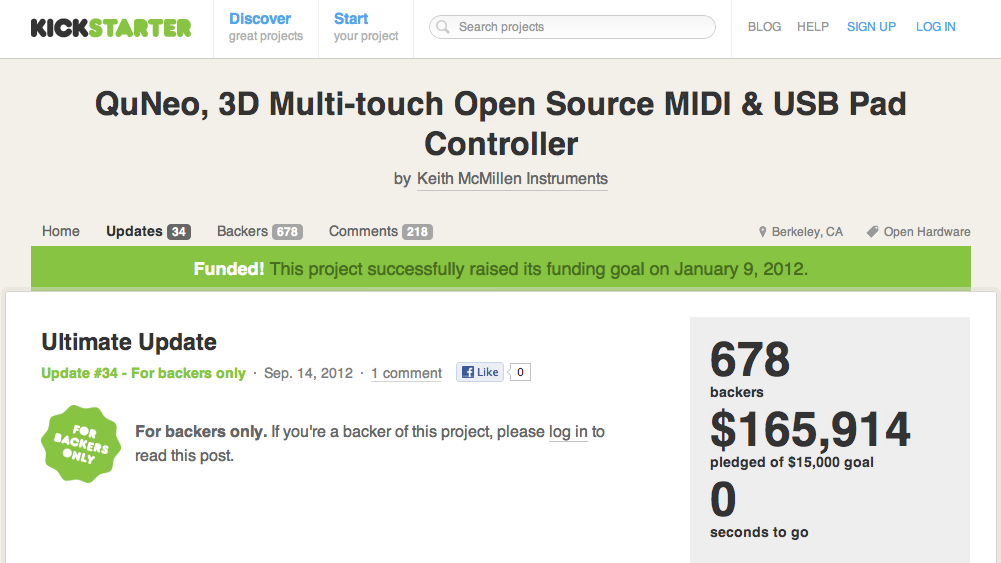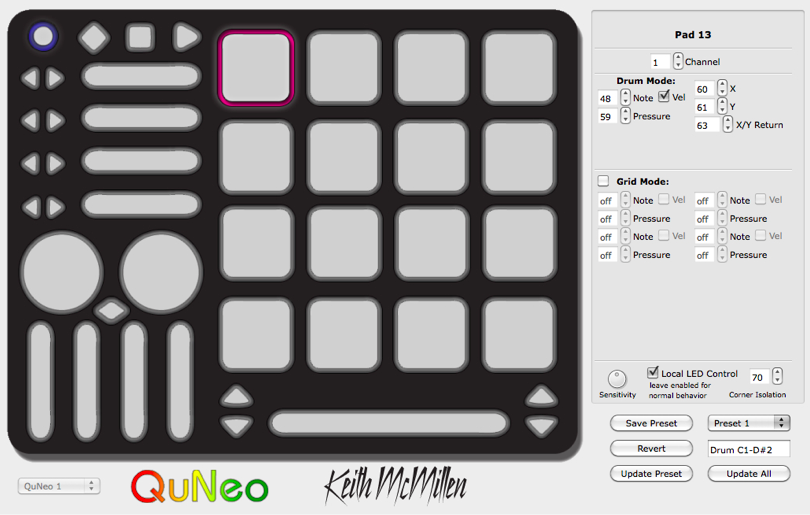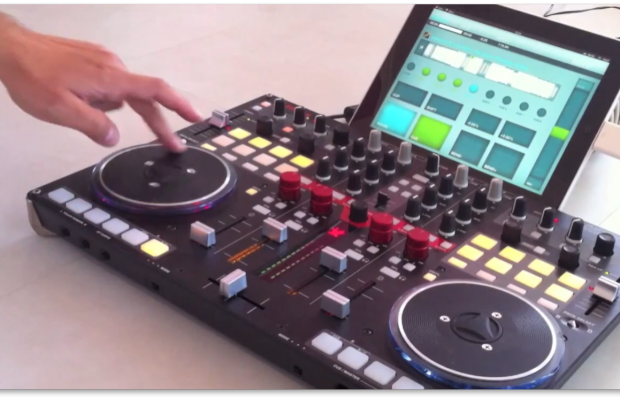Video Review
Want a controller with a difference? They don’t get much more different than the QuNeo 3D Multitouch Pad Controller. The same size as an iPad and weighing just 14oz, this beautifully made Midi controller can give you a wide degree hardware control over your DJ software on your laptop or iPad (via USB or OSC), with LED feedback that’s so good it makes the unit all but irresistible.
The QuNeo comes complete with out-of-the-box mappings for Traktor, Serato Scratch Live, Mixxx and Ableton Live (as well as drum machine, sampler and synthesiser software), but you won’t be surprised to hear that it has its own editor for coming up with your own mappings too.
It’s not just a touch controller, though; the pads, sliders and buttons are variously pressure, velocity and location sensitive, with X-Y location and continuous pressure both measurable too. And with the aforementioned multi-coloured, sometimes multiple LEDs inside each of the controls, the unit delivers an unprecedented amount of visual feedback too.
In this DJ-focused review, we test it with the supplied Traktor Pro mapping. In addition, we talk about using it with Serato Scratch Live. Finally, we explore the possibilities for using it with an iPad, which could give you a neat and compact DJ set up that’s more capable than anything the iPad has seen to date.
An introduction to the QuNeo
From Keith McMillen Instruments, the QuNeo was first spotted at the NAMM Show 2012 and is notable for the fact that it was funded via Kickstarter, a website where potential users of a new product pay upfront for it at a discounted price before it’s actually been made.
(If you’re a budding equipment designer interested in researching more about how the product came to market, there an exhaustive article about it over on DJTechTools.) Only now is the QuNeo finally shipping, and we’ve had one here in the Digital DJ Tips workshop for a weekend to get to know it.

It’s a Midi controller. That means it is designed to offer control over any software that uses Midi to communicate with hardware. That could mean anything from drum machines to samplers, synthesisers to club lighting software, video DJing packages to sequencers.
Of course, here at Digital DJ Tips, we’re most interested in how it can be used to control DJ software, and we’re going to focus on its use with Traktor. Bear in mind you could map it to Virtual DJ, djay, Cross DJ… any package that supports Midi controller mappings.
If you’re a beginner reading this though, it’s worth pointing out that it’s just a Midi controller, not a fully-fledged DJ controller. As DJing needs two independent outputs – one to go to your speakers, one to your headphones – most modern DJ controllers have a built-in audio interface to provides this for you.
The QuNeo 3D Multitouch Pad Controller, alongside many other boutique Midi controllers, doesn’t; it purely handles the Midi aspect. That means you still need to have a way of achieving this, which in practice either means using a standalone DJ audio interface (laptops), or a mono splitter cable (laptops or, currently necessarily, iOS devices).
First impressions and setting up
The QuNeo comes in small cardboard pack with a USB-to-mini USB connector (the new-style mini connector, like for Blackberry or Kindle) and a slip of paper containing four steps necessary to get it to work, all of which involve being online. You register the unit on the website, downloading and running the QuNeo Software Installer, in which you tick the software applications you’d like to use it with (the available options are Traktor, Serato Scratch Live, Mixxx, Battery, Reason and various production iPad apps and Logic).
Then, on plugging in the unit and launching the QuNeo Editors, the unit’s firmware is updated automatically if necessary, and you’re ready to go. The build quality is lovely; the unit is made from lightweight rubberised black plastic, with white controls, also rubberised, which are raised, indented or flush depending upon their intended function. It has four sturdy rubber feet, and the mini USB socket is the only I/O.

It feels like a design classic already, and I think it’s a smart move having it the same size as an iPad; for this reason alone the QuNeo begs to be used with an iPad, and also it means you can use it with iPad cases, stands and other such accessories. More later on this.
So back to set-up. Having initialised the unit, we have to get it to work with Traktor, and this is as simple as installing a mapping, just like with any other Midi controller; a Traktor .tsi file is provided, and you import it via the Traktor controller preferences panel. You need to select the Traktor preset mapping on the unit, and you do that by pressing the top left button to enter mapping select mode and pressing the pad key corresponding to the correct unit mapping, a list of which appears in the supplied instruction PDF.
In use
Nowhere near every control of Traktor is mapped here; rather, there’s enough to get you going. You will definitely want to roll your sleeves up and start coming up with your own mappings as time goes on; that’s part of the fun of such controller.
Also, the layout of the unit doesn’t scream “DJ controller”. While it has a crossfader, there are no obvious line channels and the 16 pads that dominate the unit seem much more fitting for use as sample triggers for drum machines and so on. But that’s OK; you’ll just have to use your imagination and adapt things to suit both your chosen software, your chosen style of DJing, and the controls that are available.
The fact is that there are such a variety of controls here, it is possible to use it for just about anything. And because you can program layers (as well as use the shift button within layers), the possibilities are manifold. You could even use two units – one per deck! – or alternatively, use it alongside your existing controller.

In the supplied Traktor mapping, though, it’s set up as a two-deck basic controller, with the addition of loops, cues, basic FX control (including filters) and control over the loop recorder. There’s no sample deck control, and no library functions either. The first thing I noticed is that you have to press the controls quite firmly for then to register your touch. Of course, the unit is velocity sensitive, so you can make alterations to suit your style here.
Once I’d moved the unit indoors (I was reviewing it in the morning sunshine here in Spain – not a good idea with an LED controller, because I could hardly see whether the LEDs were on or off), the second thing that struck me was just how cool having (mainly) multiple multi-coloured LEDs in each pad is. They’re mainly red, yellow, orange and green, with a few blues thrown in too, and some controls have as many as eight in them.
The amount of potential feedback you can get from these LEDs is huge, and when mapped properly will make for an extremely visually rich DJing experience. For instance, on the supplied Traktor mapping, the two vertical volume faders for the decks have VU meters built in that flash through green, yellow and red; the “decks” (read: the two round controls mid-left) “rotate” clockwise when playing; the pads flash to highlight the kick drums; and the crossfader shows you where it’s set using a particularly cute selection of every colour the unit can throw at you!
I expect users will start with this mapping and then start editing things to suit the way they DJ; the comprehensive editor manual that’s provided talks you through the process, which is quite involved because a good mapping is going to have to be two way (ie the controller will talk to your software, but your software will also send back information to allow the controller’s LEDs to react accordingly).
One thing to note is that the hardware automatically “locally” lights the LEDs for each control to show where it’s set, and there are override rules for determining how incoming signals are handled, so there’s lots of flexibility to map it exactly how you want – once you’re past the initial steeper section of the learning curve, of course.
Using with other DJ software
This could prove to be a particularly useful controller for Serato Scratch Live (“SSL”). For the uninitiated, SSL is a digital vinyl system. That means it lets you use traditional DJ gear (turntables CDJs, mixers) with your laptop and special “control vinyl (or CDs) to manipulate your digital music files. The issue with such software is that you rely on the laptop keyboard for all the extra controls like loops, cues and so on. Therefore users of “scratch” software tend to look for small Midi controllers to fulfil this need. It’s the size and weight of the QuNeo that I think would appeal to SSL DJs the most.

The supplied mappings for Serato Scratch Live are rather unnecessarily spread across three presets (unnecessarily because there are many controls unused in each preset), and they don’t really dent the surface of the controller’s capability, but the possibility of tweaking mappings to suit the controls you most use means that this is – again – just going to be your starting point.
Another system that the controller seems particularly suited for is Ableton Live, the layout obviously suiting clip launching, and the customisation options within both Ableton Live and QuNeo mean that building your own DJ system based around this with Ableton as your software could prove to be a creatively fruitful endeavour.
Last but definitely not least, remember that the unit works with OSC too, meaning you can use it with your iPad. Now if you’re one of those people who think the iPad as a potential DJ device is an exciting proposition, the QuNeo, without doubt, makes it more so.
Never mind the fact that it’s exactly the same size as the iPad (meaning the units can easily be transported and set up together), to me the combination of an iPad and a QuNeo looks like a potentially mighty capable, completely portable DJ system.
The DJ Player app for iPad already has Midi mapping in its latest beta, and assuming there turn out to be no insurmountable hurdles in doing so, making a custom mapping for that or similar software would give you one seriously cool, compact and modern DJ set-up that you could adapt to suit whatever control layout is in your imagination. For completion’s sake, let me mention too that there’s a mapping for open-source DJ program Mixxx, which is along the same lines as the Traktor mapping, attempting to be at least a semi-complete all-in-one DJ surface.
Conclusion
In pretty much every way, the QuNeo is an irresistibly cool device. The most impressive thing about it is the quality of the LED feedback; this on its own lifts the unit way above the ordinary. The touch sensitivity of the pads is great for drummers and other musicians, but the jury’s out on whether it really matters a great deal in DJing; none of the supplied DJ software mappings actually make use of it. Nonetheless, it’s there if you need it.

Of course, while this is an infinitely mappable unit, you’re still tied to the types and layout of the controls offered; and as mentioned above, while it’s certainly good for DJing, it’s not at first glance perfect for “two decks and a mixer” purposes. But then again, it’s not 100% suitable for any purpose; that’s the trade-off with a unit designed to work with all software and to do whatever is in your imagination.
True, it’s not for beginners, and it’s also not perfect (in particular, I wish the LEDs were brighter; they’re fine in subdued lighting but pretty useless in daylight). But overall it represents a leap forward in Midi controller technology.
Its crowd-funded roots, the ecosystem which will no doubt build around mapping it, and the fact that it is a desirable device in itself, mean its cult status is already assured. Whether it can do the numbers to become a major commercial success remains to be seen. I, for one, will follow its progress with great interest.
Coolest little Midi controller out there? Or impractical for DJ use? How would you consider using one of these? Any queries about it we haven’t answered? Please feel free to post away in the comments.








